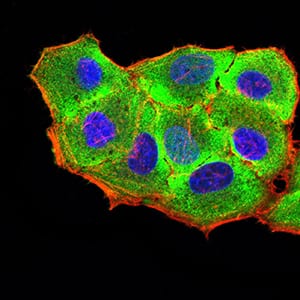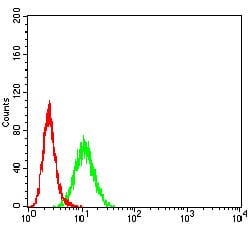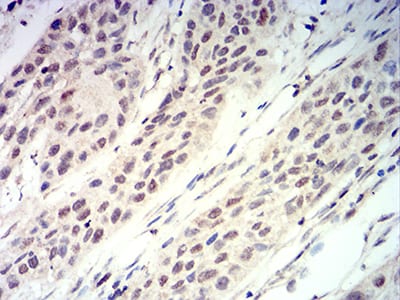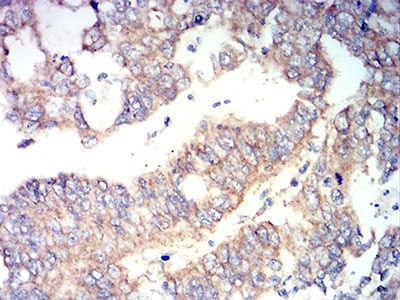




| WB | 咨询技术 | Human,Mouse,Rat |
| IF | 咨询技术 | Human,Mouse,Rat |
| IHC | 1/200 - 1/1000 | Human,Mouse,Rat |
| ICC | 1/50 - 1/250 | Human,Mouse,Rat |
| FCM | 1/200 - 1/400 | Human,Mouse,Rat |
| Elisa | 1/10000 | Human,Mouse,Rat |
| Aliases | AML2; CBFA3; PEBP2aC |
| Entrez GeneID | 864 |
| clone | 7E2B8 |
| WB Predicted band size | 44.4kDa |
| Host/Isotype | Mouse IgG2b |
| Antibody Type | Primary antibody |
| Storage | Store at 4°C short term. Aliquot and store at -20°C long term. Avoid freeze/thaw cycles. |
| Species Reactivity | Human |
| Immunogen | Purified recombinant fragment of human RUNX3 (AA: 294-429) expressed in E. Coli. |
| Formulation | Purified antibody in PBS with 0.05% sodium azide |
+ +
以下是关于RUNX3抗体的3篇代表性文献的简化信息,供参考:
---
1. **文献名称**:*RUNX3 inactivation by frequent promoter hypermethylation and protein mislocalization in gastric cancer*
**作者**:Chuang LS, et al.
**摘要**:该研究利用RUNX3特异性抗体进行免疫组化和Western blot分析,发现胃癌组织中RUNX3基因启动子区高频甲基化导致蛋白表达缺失或细胞质错误定位,提示其作为抑癌基因的功能失调与胃癌进展相关。
---
2. **文献名称**:*The RUNX3 transcription factor regulates development and survival of TrkC dorsal root ganglia neurons*
**作者**:Bangsow C, et al.
**摘要**:通过RUNX3抗体染色和基因敲除小鼠模型,揭示了RUNX3在背根神经节感觉神经元发育中的关键作用,并证明其缺失导致神经元凋亡及痛觉传导异常。
---
3. **文献名称**:*RUNX3 functions as a tumor suppressor by directly inducing p21/WAF1/Cip1 in gastric cancer*
**作者**:Ito Y, et al.
**摘要**:研究利用ChIP实验(基于RUNX3抗体)证实RUNX3通过直接激活p21基因调控细胞周期,其表达缺失与胃癌细胞增殖和化疗耐药性相关,为RUNX3的抑癌机制提供了分子证据。
---
4. **文献名称**:*Epigenetic silencing of RUNX3 in colorectal cancer*
**作者**:Lee SH, et al.
**摘要**:通过甲基化特异性PCR和RUNX3抗体免疫染色,发现结直肠癌中RUNX3因启动子甲基化而表达沉默,恢复其表达可抑制肿瘤细胞生长并诱导凋亡,提示其作为潜在治疗靶点。
---
**注**:以上为简化示例,实际文献需通过PubMed/Google Scholar检索确认准确性。
RUNX3 antibodies are essential tools for studying the RUNX3 protein, a member of the Runt-related transcription factor (RUNX) family. RUNX3 plays critical roles in cell differentiation, immune regulation, and cancer development. It functions as a transcriptional activator or repressor, depending on cellular context, and is involved in TGF-β signaling pathways. RUNX3 is particularly notable for its tumor-suppressive activity in gastric, colorectal, and other epithelial cancers, where its inactivation via promoter hypermethylation or mutations is linked to oncogenesis.
These antibodies are widely used in techniques like Western blotting, immunohistochemistry (IHC), and immunofluorescence (IF) to detect RUNX3 expression levels, subcellular localization, and post-translational modifications. Researchers employ them to investigate RUNX3's role in tissue-specific gene regulation, immune cell maturation (e.g., T cells and dendritic cells), and its dual functions in cancer progression—acting as either a tumor suppressor or context-dependent oncogene. Commercially available RUNX3 antibodies are typically raised against specific epitopes in human or mouse RUNX3. with validation in knockout cell lines to ensure specificity.
In clinical research, RUNX3 antibody-based assays help correlate protein expression patterns with disease prognosis, therapeutic responses, or epigenetic silencing in tumors. They also facilitate studies on RUNX3's involvement in autoimmune disorders and inflammatory conditions. Proper antibody selection requires consideration of cross-reactivity with other RUNX family members (RUNX1/2) and species compatibility.
×